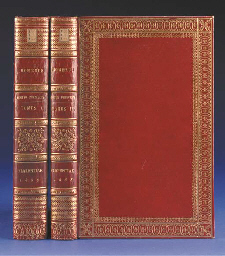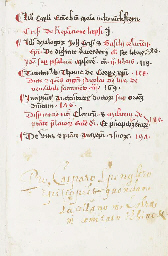BIBLE, Latin . [Basel: Berthold Ruppel (part I) and Bernhard Richel (part II), not after 1474]. 2 parts in one volume, royal 2° (398 x 292mm). Collation: [1-22 10 ; 23-42 10 43-44 8 ] (1/1r prologue to Genesis, 23/1r Proverbs). 220, 216 leaves. 50 lines (part I), 48 lines (part II), double column. Types: 2:112G (part I); 1:119G (part II), with woodcut capitals 1. Part I with one large red and blue Lombard initial with red pen-flourishing and reserved ornament modelled in brown ink; part II with the woodcut initials highlighted in red or blue; both parts rubricated with simple Lombard initials in red and blue, red capital strokes, book headings and chapter numbers throughout and headlines to New Testament only supplied in red, instructions for rubricator visible in margins, contemporary manuscript quiring on first recto of each quire. With the penultimate line of 31/1v col. 2 stamped in at the foot of the column and marked by the rubricator. Two pinholes visible, one each in top and bottom margins. (Dampstains to some margins, minor fraying to lower margins of last c. 100 leaves, old repairs to margins of first leaf and last 6 leaves, printing flaw to 21/7r with portions of 8 lines unprinted, first and last pages slightly darkened, a few small wormholes.) Contemporary undecorated German pigskin over wooden boards with plaited leather headbands, preserving some deckle edges, evidence of two clasps (some wear, repairs to joints, a few small wormholes). Provenance : scattered early annotations -- He. Institor, possibly the author of Malleus maleficarum (inscription on 1/1r beginning with a monogram: HEINstitor me possidet ) -- erased 17th-century inscription of a religious community on 1/1r -- Augustus Frederick, Duke of Sussex (1773-1843, sixth son of King George III; sale, Evans, 4 July 1844, lot 722; this copy described in T.J. Pettigrew, Bibliotheca Sussexiana , vol. 1 part 2, pp. 303-5) -- George Livermore of Dana Hill, Cambridge, Massachusetts (bookplate; his books were deposited at Harvard University from 1859, after his death, until they were surrendered to his executors on 9 November 1894; sale, Libbie, 20 November 1894, lot 110) -- Dean Hoffman; presented to -- General Theological Seminary (bookplate; sale, Christies New York, 1 October 1980, lot 6) -- Ned J. Nakles (sale Christie's New York, 17 April 2000, lot 155). SECOND BIBLE PRINTED AT BASEL. Berthold Ruppel, who worked with Gutenberg at Mainz and testified on his behalf in the 1455 suit brought by Johann Fust is generally credited with the introduction of printing to Basel. Three books, a Gregorius Moralia in Job , a Nicolaus de Lyra Postilla super Evangelia and the present Latin Bible, all printed in an archaic type modelled on Fust and Schoeffer's 1462 Bible type, are thought to be Ruppel's earliest; of the three, the Gregorius was long given primacy on the basis of a manuscript acquisition date of 1468 in a copy at the Bibliothèque nationale de France, proved in 1938 to be a later forgery. Typographical evidence indicates that the Bible preceded the Gregorius, and the annotated edition of BMC proposes that it was executed first, followed by the Nicolaus de Lyra. CIBN dates the Bible to c. 1472-1473, BSB-Ink. to c. 1473; a terminus ante quem is provided by a rubricator's date of 1474 in the Wolfenbüttel copy. Although Ruppel printed part I and Richel part II of this Bible, they used a single paper stock and the types of the two sections resemble each other. Like most other early printed Bibles, this one takes both its text and its format from the tradition established by the Gutenberg Bible. It was set probably from Heinrich Eggestein's first Vulgate Bible, which was itself set from a copy of the Gutenberg Bible (cf. P. Needham, 'The Text of the Gutenberg Bible,' in Trasmissione dei testi a stampa nel periodo moderno , vol. 2, Rome 1987, pp. 43-84). In part II of this edition the penultimate line was omitted from 31/1v, column 2; in most copies, including thi
BIBLE, Latin . [Basel: Berthold Ruppel (part I) and Bernhard Richel (part II), not after 1474]. 2 parts in one volume, royal 2° (398 x 292mm). Collation: [1-22 10 ; 23-42 10 43-44 8 ] (1/1r prologue to Genesis, 23/1r Proverbs). 220, 216 leaves. 50 lines (part I), 48 lines (part II), double column. Types: 2:112G (part I); 1:119G (part II), with woodcut capitals 1. Part I with one large red and blue Lombard initial with red pen-flourishing and reserved ornament modelled in brown ink; part II with the woodcut initials highlighted in red or blue; both parts rubricated with simple Lombard initials in red and blue, red capital strokes, book headings and chapter numbers throughout and headlines to New Testament only supplied in red, instructions for rubricator visible in margins, contemporary manuscript quiring on first recto of each quire. With the penultimate line of 31/1v col. 2 stamped in at the foot of the column and marked by the rubricator. Two pinholes visible, one each in top and bottom margins. (Dampstains to some margins, minor fraying to lower margins of last c. 100 leaves, old repairs to margins of first leaf and last 6 leaves, printing flaw to 21/7r with portions of 8 lines unprinted, first and last pages slightly darkened, a few small wormholes.) Contemporary undecorated German pigskin over wooden boards with plaited leather headbands, preserving some deckle edges, evidence of two clasps (some wear, repairs to joints, a few small wormholes). Provenance : scattered early annotations -- He. Institor, possibly the author of Malleus maleficarum (inscription on 1/1r beginning with a monogram: HEINstitor me possidet ) -- erased 17th-century inscription of a religious community on 1/1r -- Augustus Frederick, Duke of Sussex (1773-1843, sixth son of King George III; sale, Evans, 4 July 1844, lot 722; this copy described in T.J. Pettigrew, Bibliotheca Sussexiana , vol. 1 part 2, pp. 303-5) -- George Livermore of Dana Hill, Cambridge, Massachusetts (bookplate; his books were deposited at Harvard University from 1859, after his death, until they were surrendered to his executors on 9 November 1894; sale, Libbie, 20 November 1894, lot 110) -- Dean Hoffman; presented to -- General Theological Seminary (bookplate; sale, Christies New York, 1 October 1980, lot 6) -- Ned J. Nakles (sale Christie's New York, 17 April 2000, lot 155). SECOND BIBLE PRINTED AT BASEL. Berthold Ruppel, who worked with Gutenberg at Mainz and testified on his behalf in the 1455 suit brought by Johann Fust is generally credited with the introduction of printing to Basel. Three books, a Gregorius Moralia in Job , a Nicolaus de Lyra Postilla super Evangelia and the present Latin Bible, all printed in an archaic type modelled on Fust and Schoeffer's 1462 Bible type, are thought to be Ruppel's earliest; of the three, the Gregorius was long given primacy on the basis of a manuscript acquisition date of 1468 in a copy at the Bibliothèque nationale de France, proved in 1938 to be a later forgery. Typographical evidence indicates that the Bible preceded the Gregorius, and the annotated edition of BMC proposes that it was executed first, followed by the Nicolaus de Lyra. CIBN dates the Bible to c. 1472-1473, BSB-Ink. to c. 1473; a terminus ante quem is provided by a rubricator's date of 1474 in the Wolfenbüttel copy. Although Ruppel printed part I and Richel part II of this Bible, they used a single paper stock and the types of the two sections resemble each other. Like most other early printed Bibles, this one takes both its text and its format from the tradition established by the Gutenberg Bible. It was set probably from Heinrich Eggestein's first Vulgate Bible, which was itself set from a copy of the Gutenberg Bible (cf. P. Needham, 'The Text of the Gutenberg Bible,' in Trasmissione dei testi a stampa nel periodo moderno , vol. 2, Rome 1987, pp. 43-84). In part II of this edition the penultimate line was omitted from 31/1v, column 2; in most copies, including thi















Testen Sie LotSearch und seine Premium-Features 7 Tage - ohne Kosten!
Lassen Sie sich automatisch über neue Objekte in kommenden Auktionen benachrichtigen.
Suchauftrag anlegen